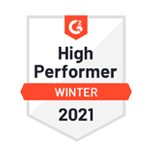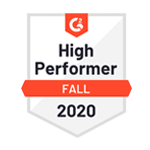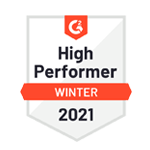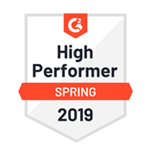The clipboard-and-checkbox approach to evaluating recruiters is dead. Buried alongside paper resumes and fax machines. Today’s competitive talent market demands something far more sophisticated—a performance review framework that captures both quantitative outcomes and qualitative impact.
Most recruitment leaders still evaluate their teams based on gut feelings. The data tells a different story. Organizations using structured, metrics-driven recruiter performance reviews report 37% higher quality of hire and significantly improved retention rates. Numbers don’t lie—but they don’t tell the complete truth either when trapped in disconnected systems.
The Hidden Cost of Manual Recruiter Performance Tracking
Traditional performance reviews are killing your recruitment productivity. Here’s the uncomfortable truth: your team spends more time collecting data than analyzing it.
Manual tracking creates invisible inefficiencies. Recruiters waste 4-6 hours weekly gathering metrics from different platforms. They jump between ATS systems, spreadsheets, and email threads. Meanwhile, critical performance insights slip through the cracks.
Spreadsheet-based reviews miss critical performance indicators entirely. You track time-to-fill but ignore candidate satisfaction scores. Cost-per-hire gets measured while diversity pipeline strength goes unnoticed. The result? Incomplete pictures that lead to misguided coaching decisions.
The time drain affects everyone. Managers spend entire afternoons compiling reports instead of developing talent. Recruiters become defensive when reviews feel subjective or incomplete. Team morale suffers when performance discussions lack a concrete foundation.
Most damaging is the delayed response to performance issues. By the time problems surface in quarterly reviews, damage is done. Top candidates have been lost. Client relationships have suffered. Revenue targets have been missed.
This reactive approach costs more than productivity. It damages team trust and retention when performance conversations feel arbitrary or unfair.
Essential Recruiter Performance KPIs That RecruitBPM Tracks Automatically
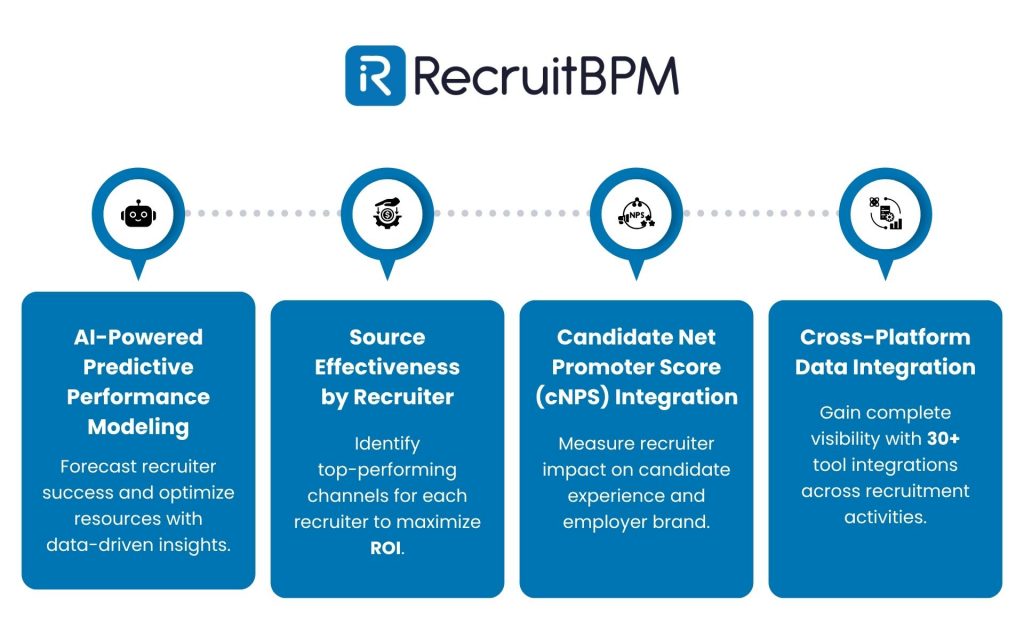
RecruitBPM eliminates guesswork with comprehensive performance tracking. The platform captures every metric that matters for modern recruitment success.
Time-to-Fill vs Quality-of-Hire: Real-Time Balance in RecruitBPM Dashboards
Speed versus quality creates recruitment’s biggest tension. RecruitBPM’s dashboard visualizes this balance instantly. Real-time widgets show how individual recruiters perform across both dimensions.
The platform tracks time-to-fill from job posting to offer acceptance. But it goes deeper. Quality-of-hire metrics include 90-day retention rates, hiring manager satisfaction scores, and performance review outcomes. This dual tracking prevents the common mistake of optimizing for speed while sacrificing quality.
Advanced analytics reveal patterns others miss. A recruiter filling roles quickly might seem successful until dashboard data reveals poor candidate retention. Another’s slower metrics might mask exceptional work with hard-to-fill technical positions.
Candidate Experience Metrics Made Simple with Automated Tracking
Candidate experience directly impacts your employer brand and future talent pipeline. RecruitBPM automatically captures candidate feedback throughout the recruitment journey.
The system tracks response times to candidate inquiries, interview scheduling efficiency, and communication quality scores. Candidate Net Promoter Scores get collected through automated surveys. These insights help identify recruiters who excel at relationship building versus those who need coaching.
Real-time alerts notify managers when candidate experience scores drop below benchmarks. This proactive approach prevents negative reviews and protects your talent brand.
Pipeline Conversion Analytics: From Application to Placement
Understanding where candidates drop off reveals performance improvement opportunities. RecruitBPM’s funnel analytics show conversion rates at every stage.
The platform tracks application-to-screening ratios, interview-to-offer percentages, and offer-to-acceptance rates. These metrics help identify whether recruiters struggle with sourcing quality candidates, conducting effective interviews, or closing offers successfully.
Individual performance dashboards highlight each recruiter’s strengths and development areas. Managers can provide targeted coaching based on specific conversion bottlenecks.
Cost-Per-Hire Breakdown Beyond Basic Numbers
RecruitBPM’s cost analysis goes beyond simple division. The platform breaks down expenses by source, recruiter, and role type.
Detailed reporting shows which recruiters generate the most cost-effective hires. Sourcing channel analysis reveals platform effectiveness by individual team members. This granular data helps optimize budget allocation and training focus.
The system tracks hidden costs, too—time spent on failed searches, rework expenses, and opportunity costs of unfilled positions.
RecruitBPM’s Performance Dashboard: Your Complete KPI Command Center
RecruitBPM’s dashboard transforms performance management from reactive to proactive. Visual widgets and compelling analytics display vital recruiting metrics in digestible formats.
Customizable Widgets for Every Recruitment Role
Different roles need different metrics. Senior recruiters focus on client relationship scores and strategic pipeline development. Junior recruiters track activity metrics and skill development progress.
RecruitBPM’s customizable dashboard adapts to individual needs. Drag-and-drop widgets let managers create role-specific views. Sales-focused recruiters see business development metrics prominently. Volume recruiters get activity and efficiency widgets.
The platform combines information from across RecruitBPM into unified dashboards. No more jumping between systems or compiling manual reports.
Real-Time Performance Alerts That Prevent Problems
Proactive alerts catch issues before they become crises. RecruitBPM monitors key performance indicators continuously and triggers notifications when metrics fall outside acceptable ranges.
Managers receive alerts when candidate response rates drop, interview-to-offer ratios decline, or client satisfaction scores fall. This early warning system enables immediate coaching interventions.
Automated triggers can launch training modules, schedule one-on-one meetings, or assign mentorship partnerships. Performance issues get addressed in real-time rather than quarterly reviews.
Executive-Level Reports in One Click
Leadership needs high-level insights without operational details. RecruitBPM’s executive dashboards provide strategic overviews with drill-down capabilities.
Board-ready reports show team performance trends, cost-per-hire analysis, and quality-of-hire metrics. Revenue impact calculations demonstrate recruitment’s contribution to business outcomes.
One-click reporting saves hours of manual compilation while ensuring accuracy and consistency across reporting periods.
AI-Powered Trend Analysis for Proactive Management
RecruitBPM’s artificial intelligence identifies performance patterns that human analysis might miss. The system analyzes historical data to predict future performance trends.
AI algorithms spot early warning signs of recruiter burnout, identify high-potential team members, and suggest optimization opportunities. Predictive analytics help managers make proactive decisions about training, workload distribution, and career development.
Machine learning improves recommendations over time, becoming more accurate as the system processes more performance data.
Setting Up Automated Performance Reviews in RecruitBPM
Implementation starts with strategic planning. Define performance standards aligned with business objectives before configuring dashboard settings.
Configuring Individual Recruiter Scorecards
RecruitBPM’s scorecard feature creates personalized performance profiles for each team member. Managers select relevant KPIs based on role responsibilities and experience levels.
The system weights different metrics according to business priorities. Client-facing roles emphasize relationship metrics. High-volume positions prioritize efficiency measures. Strategic roles focus on quality indicators.
Scorecards update automatically as new performance data flows through the system. Historical trending shows progress over time and identifies improvement patterns.
Building Team Performance Benchmarks
Effective benchmarking requires industry context and internal baselines. RecruitBPM helps establish realistic performance standards based on role type, market conditions, and organizational goals.
The platform analyzes team performance data to identify top performer characteristics. These insights help set achievable yet challenging benchmarks for the entire team.
Benchmark adjustments occur automatically as market conditions change or team capabilities improve. This dynamic approach keeps standards relevant and motivating.
Creating Automated Performance Improvement Triggers
RecruitBPM’s workflow automation launches improvement programs when performance indicators decline. Managers define trigger conditions and corresponding actions.
When metrics fall below thresholds, the system can assign training modules, schedule coaching sessions, or provide additional resources. This automation ensures a consistent response to performance issues.
Automated documentation tracks improvement efforts and outcomes. This creates comprehensive performance histories that support promotion decisions and performance management discussions.
Integrating Post-Hire Success Metrics
True performance measurement extends beyond placement. RecruitBPM integrates with HRIS systems to track post-hire performance indicators.
New hire retention rates, performance review scores, and promotion timelines get linked back to individual recruiters. This connection shows the long-term impact of recruitment decisions.
Post-hire analytics identify recruiters who consistently place high-performing candidates versus those who prioritize quick fills over quality matches.
Advanced Analytics Features That Set RecruitBPM Apart
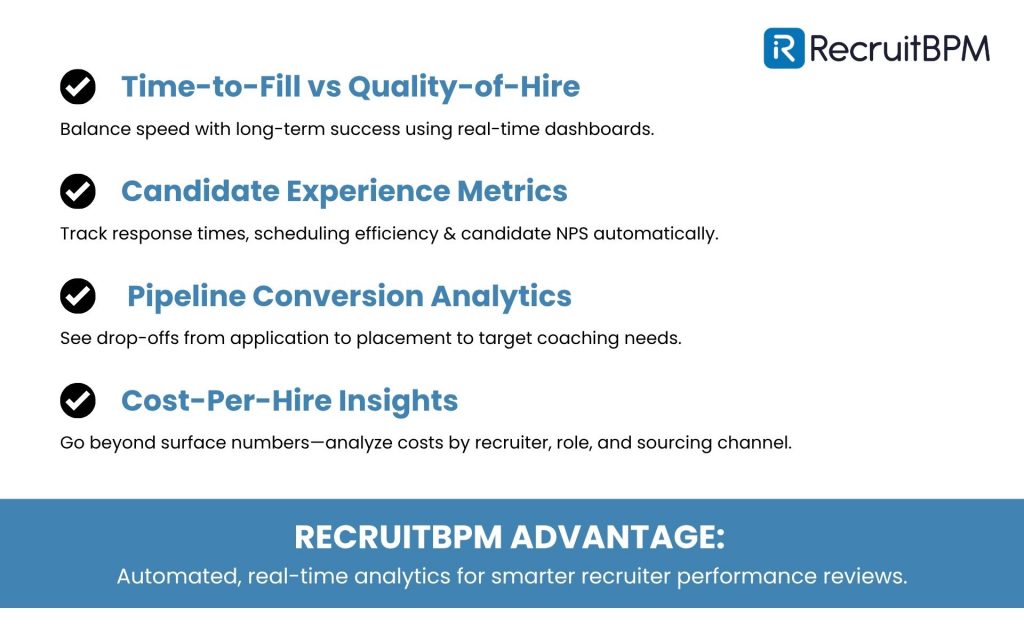
RecruitBPM’s advanced capabilities go beyond basic performance tracking. Sophisticated analytics provide insights that transform recruitment strategy.
Predictive Performance Modeling with AI Insights
Machine learning algorithms analyze performance patterns to predict future outcomes. The system identifies recruiters likely to exceed targets and those needing additional support.
Predictive models help with resource allocation, training prioritization, and succession planning. Managers can make proactive decisions based on data-driven forecasts rather than reactive responses to problems.
AI insights reveal hidden correlations between activities and outcomes. These discoveries help optimize recruitment processes for better performance across the entire team.
Source Effectiveness Analysis by Individual Recruiter
Different recruiters excel with different sourcing channels. RecruitBPM tracks source effectiveness by individual team member, revealing optimization opportunities.
The platform analyzes which job boards, social media platforms, and referral programs work best for each recruiter. This personalization maximizes sourcing ROI and improves candidate quality.
Source performance data helps with budget allocation and training focus. Recruiters can concentrate on channels where they achieve the best results.
Candidate Net Promoter Score Integration
RecruitBPM automatically collects candidate feedback through surveys and integrates Net Promoter Scores into performance evaluations. This candidate experience data provides crucial insights into recruiter effectiveness.
High cNPS scores indicate recruiters who create positive experiences even for unsuccessful candidates. These skills contribute to employer brand strength and future talent pipeline development.
Low scores trigger coaching interventions and process improvements. The system tracks improvement efforts and measures their impact on candidate satisfaction.
Cross-Platform Data Integration for Complete Visibility
RecruitBPM integrates with over 30 marketplace tools and applications. This connectivity provides comprehensive performance visibility across all recruitment activities.
Email tracking shows communication effectiveness. Calendar integration reveals activity patterns. Job board connections track sourcing performance. Social media analytics measure employer brand impact.
This unified data view eliminates blind spots and provides complete performance pictures that single-platform solutions cannot match.
How RecruitBPM Transformed Performance Reviews?
Customer testimonials demonstrate RecruitBPM’s impact on performance management effectiveness. Real results show measurable improvements in team productivity and satisfaction.
Derek Iannelli-Smith, Owner at Outsourced CIO LLC, shares his experience: “RecruitBPM gets my wholehearted vote. Price, features, simplicity—but the real reasons are responsiveness, efficiency, and effectiveness.” His team saw marked improvement in both internal and external recruiting processes.
A consulting firm reported significant value from RecruitBPM’s applicant tracking system simplicity and efficiency. The platform’s scalable, affordable, and KPI-driven approach delivered results within months of implementation.
Performance review time decreased by 45% as automated data collection eliminated manual report compilation. Managers spend more time coaching and developing talent rather than gathering metrics.
Team accountability improved as objective performance data replaced subjective evaluations. Recruiters appreciate transparent, fair assessment processes based on measurable outcomes.
ROI calculations show clear returns from data-driven performance management. Improved hiring quality, reduced turnover, and increased team efficiency more than offset platform costs.
Implementation Roadmap: Your Step-by-Step Success Guide
Strategic implementation ensures maximum value from RecruitBPM’s performance management capabilities. This comprehensive approach minimizes disruption while accelerating results.
Dashboard Configuration and KPI Selection
Start by identifying key performance indicators aligned with business objectives. Consider role differences, experience levels, and strategic priorities when selecting metrics.
Configure individual dashboards for each team member. Include relevant widgets and customize views based on responsibilities. Set up executive-level reporting for leadership visibility.
Establish benchmark standards using historical data and industry comparisons. Define acceptable performance ranges and trigger points for coaching interventions.
Historical Data Import and Baseline Setting
Import existing performance data to establish baseline measurements. RecruitBPM’s migration tools help transfer information from previous systems with minimal effort.
Analyze historical trends to identify performance patterns and improvement opportunities. Use this analysis to refine KPI selections and benchmark settings.
Train managers on dashboard interpretation and performance coaching techniques. Ensure leadership understands how to use analytics for strategic decision-making.
Team Training and Workflow Integration
Introduce RecruitBPM’s performance features to the recruitment team. Focus on transparency benefits and personal development opportunities rather than monitoring aspects.
Integrate performance dashboards into existing workflows. Schedule regular review sessions and establish coaching protocols based on automated alerts.
Create performance improvement resources and training materials. Link these resources to automated triggers for a consistent response to performance issues.
Advanced Features and Performance Optimization
Activate AI-powered analytics and predictive modeling features. Use these insights to optimize resource allocation and training priorities.
Review initial performance data and adjust settings as needed. Fine-tune benchmarks, modify widget configurations, and refine automation rules.
Establish ongoing optimization processes for continuous improvement. Schedule regular reviews of performance management effectiveness and make adjustments based on results.
Common RecruitBPM Performance Review Mistakes
Even powerful tools can be misused. Avoid these common implementation pitfalls that reduce RecruitBPM’s performance management effectiveness.
Over-customization creates dashboard chaos rather than clarity. Too many widgets and metrics overwhelm users and obscure important insights. Focus on essential KPIs that drive business results.
Ignoring the human element in data interpretation leads to mechanical performance discussions. Numbers provide context, but managers must understand individual circumstances and development needs.
Setting unrealistic benchmarks without industry context demotivates teams and reduces engagement. Use RecruitBPM’s analytics to establish achievable yet challenging performance standards.
Treating performance dashboards as surveillance tools rather than development resources creates resistance and reduces effectiveness. Emphasize improvement opportunities and career development benefits.
Failing to provide adequate training on analytics interpretation limits adoption and value realization. Invest in manager coaching and team education for maximum impact.

The Future of Recruiter Performance Management with RecruitBPM
RecruitBPM continues evolving to meet changing recruitment needs. Upcoming features will further enhance performance management capabilities.
Advanced AI features will predict performance trends with greater accuracy. Machine learning algorithms will identify optimization opportunities and suggest improvement strategies.
The integration roadmap includes emerging HR technologies and evolving recruitment platforms. This connectivity ensures comprehensive performance visibility as the recruitment landscape changes.
Building a culture of continuous improvement through data becomes easier as RecruitBPM adds collaborative features and team development tools.
The future belongs to recruitment teams that balance the science of metrics with the art of human potential. RecruitBPM provides the foundation for this transformation.
Getting Started: Your RecruitBPM Performance Review Transformation
Ready to transform your recruiter performance reviews from subjective guesswork to data-driven development? RecruitBPM makes the transition seamless and immediately valuable.
Start with a free trial to experience performance dashboard capabilities firsthand. See how automated metrics collection eliminates manual reporting while providing deeper insights into team effectiveness.
Book a customized demo to explore features specific to your recruitment challenges. RecruitBPM’s team will configure dashboards that address your unique performance management needs.
Migration assistance ensures smooth transitions from current systems. Import historical data, transfer workflows, and maintain continuity while upgrading to advanced analytics capabilities.
Don’t let another quarter pass with incomplete performance insights. Your recruitment team deserves better than clipboard evaluations and spreadsheet reports.
Experience the power of data-driven performance management. Transform recruiter development from reactive conversations to proactive talent optimization.
The future of recruitment performance management is here. It’s measurable, actionable, and immediately available through RecruitBPM’s comprehensive analytics platform.
Take the first step toward performance review transformation today.



